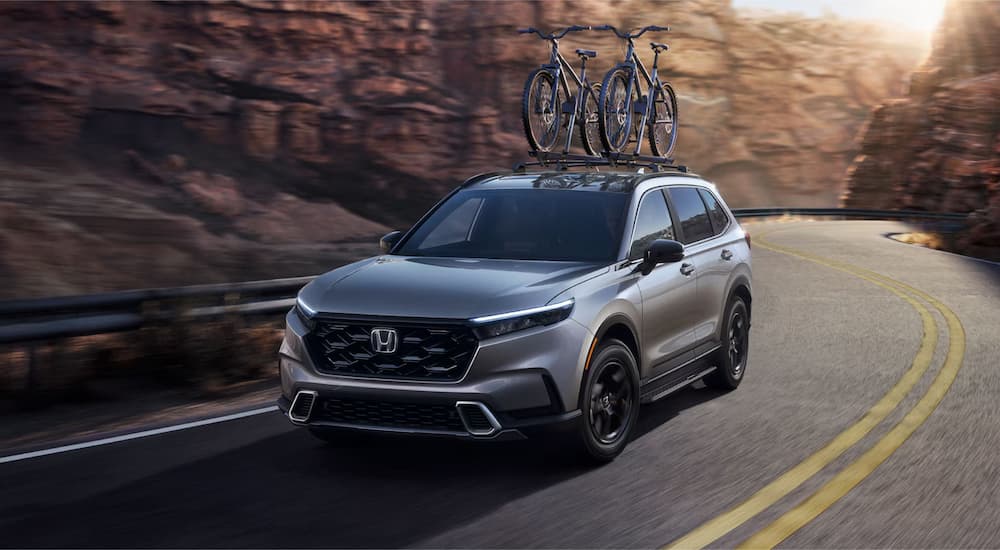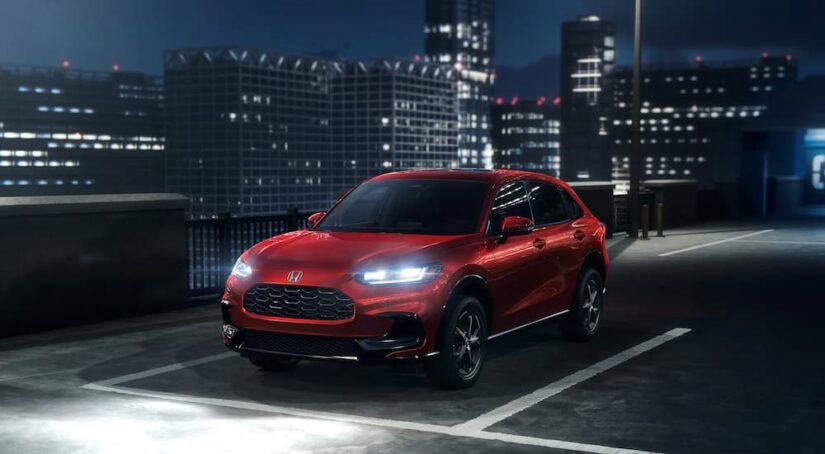Most drivers are familiar with the Honda CR-V, as it’s one of the longest-running SUV nameplates for the brand, but did you know that the CR-V has a smaller sibling, the HR-V? This subcompact superstar is filled with desirable features—many of which you can find in the CR-V—but it comes with a host of its own benefits that it offers drivers. If you’re interested in a Honda HR-V for sale, you may be wondering if this subcompact traveler will be able to meet your needs or if the larger CR-V is the more accommodating option. When it comes to the 2025 HR-V vs the 2025 CR-V, which model is right for you? Let’s find out!
Subcompact vs Compact
The biggest difference between the two models is size, as the HR-V is in the subcompact segment, while the CR-V occupies a spot in the compact realm. You would think that it would be a no-brainer to choose the larger option; however, the CR-V doesn’t work for everyone. If you’re seeking out a vehicle that’s small and easy to maneuver, the HR-V has you covered, with its subcompact stature able to whizz through traffic effortlessly and fit into any type of parking space with ease. Subcompact SUVs handle very similarly to sedans, so if you’re used to driving a car, the HR-V will be a breeze.
The HR-V is a great pick for those frequently traveling on bustling city streets, filled with traffic, pedestrians, tourists, and seemingly endless redlights. It’s small enough to weave in and out of jam-packed interstates as well, making it a top option for daily commuters of all types. It’s also a trusted pick for new drivers, as it’s easy to drive and a bit sturdier than many sedans out there. All in all, if you want a small-size traveler that can fit into streetside parking spaces effortlessly, handles much like a sedan, and still offers you the space and capabilities of an SUV, the HR-V is a fabulous choice.
On the other hand, the CR-V offers a bit more space, which is desirable for those traveling with more people and gear. Typically, commuters travel alone, which is why the HR-V is such a solid pick, but the CR-V appeals to those who need a bit more room inside, whether it’s for extra gear or a couple of little ones. The CR-V is appealing to families, especially those who aren’t interested in driving a large and in-charge full-size SUV around town. Compared to the HR-V, the CR-V ‘s larger stance makes it a little tougher to fit into any parking space you please, especially those ultra-compact spots in parking garages, and it doesn’t drive quite as similarly to a car, but close to it.
The HR-V offers up to 55.1 cu.ft. for all your cargo, while the CR-V offers up to 76.5 cu.ft. As you can see, it’s not a huge difference, but it can make a difference for some. Both the HR-V and CR-V are small-size travelers, with the HR-V better equipped to handle city driving and everyday commutes. The CR-V offers a slightly larger build, perfect for small families and those traveling with more.
Fuel Efficiency and Performance
Both Honda SUVs offer incredible fuel economy ratings, which makes both ideal for many drivers these days. The HR-V is equipped with a 2.0L four-cylinder engine that allows you to get an EPA-estimated 26 MPG in the city and 32 MPG on the highway. As mentioned above, its small size makes it extremely agile in any situation you find yourself in next, and with available all-wheel drive capabilities, dealing with bad weather road conditions is easier with the HR-V in charge of the journey. With the added traction and stability you need to maneuver through difficult conditions, you’ll be able to take on any type of commute in this subcompact winner.
The CR-V comes standard with a 1.5L turbocharged four-cylinder engine that gets an EPA-estimated 28 MPG in the city and 34 MPG on the highway. As you can see, both of these SUVs get similar gas mileage, which makes them great everyday drivers. The CR-V is reported to be easy to handle, yet compared to others in its segment, it’s not as exciting on the road. The CR-V offers a no-nonsense ride, not an exhilarating one, which is typically what its demographic is looking for anyway. Ultimately, both SUVs offer superior fuel efficiency and performance to your ride, making both phenomenal picks for your journey.

Trims and Tech
Another area where both of these SUVs are very similar to each other is with their trims and tech options. Both the HR-V and CR-V offer top-of-the-line EX-L models, which feature leather-trimmed appointments, a one-touch power moonroof, and heated front seats to elevate comfort during your journey. The HR-V’s mid-level trim is called the Sport and showcases exciting features to intensify its athleticism, like a chrome exhaust finisher, a roofline spoiler, and 18-inch gloss-black alloy wheels, plus cloth seats and a leather-wrapped steering wheel inside to add to its sporty appeal. The CR-V’s mid-level trim is the EX, which offers cloth upholstery, a power driver’s seat, and a power moonroof to let the light shine in.
Both models offer a base trim called the LX, which blends practicality and comfort to make for an appealing ride. From full LED lighting elements and 17-inch/18-inch alloy wheels outside to cloth seats and automatic climate control inside, these base models offer you what you need to enjoy the ride. You’ll find that both the HR-V and CR-V offer either a seven-inch or a nine-inch touchscreen display, as well as available wireless smartphone capabilities, an available wireless phone charger, parking sensors, and more appealing tech features as you make your way up the trim levels. Those who prioritize tech will be drawn to both, but it’s important to note that while the HR-V offers tech features that are much in line with its segment, the CR-V is lagging a bit behind its segment, especially when it comes to touchscreen options.
Price Differences
Price is another area where these two models differ, and if you’re on the hunt for a cost-conscious solution to your daily commute, the HR-V will provide this to you. With a starting price of around $25K, the HR-V is ultra-appealing to those on a budget, as well as first-time car buyers seeking out an affordable everyday driver. It’s also great for parents who are seeking out an additional vehicle for the new driver in the house, making the HR-V a fabulous choice for those with their budget on their mind.
The CR-V starts at approximately $30K, which can be a bit steep for those on a budget. It’s not luxury territory; however, it doesn’t always jive with those who want to keep their monthly payments as low as possible without sacrificing quality. Compared to midsize and full-size SUVs, though, which are geared toward families as well, the compact CR-V is much more affordable, which appeals to small families and those who want more space but don’t want to pay more for their SUV.

The HR-V or the CR-V: Which Should You Choose?
When it comes to the subcompact HR-V and the compact CR-V, although both of these models are fantastic picks, they don’t always work for the same demographic of travelers. The HR-V is ideal for daily commuters and city dwellers who need a small-size vehicle that fits virtually anywhere. It’s also outstanding for those on a budget with its ultra-affordable sticker price.
The CR-V offers more space for people and gear, which appeals to small families and those traveling with additional passengers and cargo. It’s a bit more expensive than the HR-V and a little more challenging to fit into the tiniest parking spaces in the city, but it’s great on gas and versatile. In the end, the choice is yours to make, but one thing is certain—both of these SUVs are Hondas through and through, and they will continue to offer you a reliable ride for miles, holding their value among the best in the industry.



